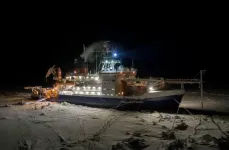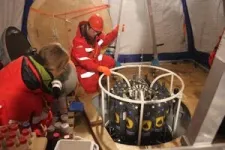(Press-News.org) A new study has shed unprecedented light on the highly variable and climate-sensitive routes that substances from Siberian rivers use to travel across the Arctic Ocean. The findings raise fresh concerns about the increasing spread of pollutants and the potential consequences for fragile polar ecosystems as climate change accelerates.
The international research, published today in Nature Communications and led by the University of Bristol, in the UK, provides the clearest ever picture of how the underlying transport system, known as the Transpolar Draft, operates. It also uncovers the various factors controlling this major Arctic surface current, including warmer temperatures which could increase the spread of human-made pollutants.
The Transpolar Drift carries sea ice, fresh water, and suspended matter from the Siberian shelves across the central Arctic towards the Fram Strait channel, which connects to the Nordic Seas.
This cross-Arctic flow influences the delivery of both natural substances, such as nutrients, gases, organic compounds, and human-made pollutants – including microplastics and heavy metals – from Siberian river systems into the central Arctic and the North Atlantic. This material affects Arctic biogeochemistry and ecosystems, while the fresh water itself alters ocean circulation.
As the Arctic Ocean is a highly changeable environment, rather than following a steady course, river-sourced matter takes diverse, seasonally shifting routes shaped by changing shelf conditions and ocean currents, along with the formation, drift, and melting of sea ice. This results in rapid and widespread redistribution of both natural and pollutant matter.
Lead author Dr Georgi Laukert, Marie Curie Postdoctoral Fellow in Chemical Oceanography at the University of Bristol, UK and Woods Hole Oceanographic Institution in Massachusetts, US, said: “We found pronounced changes in the composition of Siberian river water along the Transpolar Drift, demonstrating this highly dynamic interplay. Seasonal shifts in river discharge and dynamic circulation on the Siberian shelf drive ocean surface variability, while interactions between sea ice and the ocean further increase the redistribution of river-borne matter.
“Another key discovery is the increasingly central role of sea ice formed along the Transpolar Drift – not only as a passive transport medium, but as an active agent in shaping dispersal patterns. This sea ice captures material from multiple river sources during growth, unlike most coastal sea ice, creating complex mixtures that are transported across vast distances.”
To decode these complex pathways, the international research team analysed seawater, sea ice, and snow samples using oxygen and neodymium isotopes, along with measurements of rare earth elements to produce geochemical tracer data. This geochemical fingerprinting allowed the researchers to track the origins of river-sourced matter and follow how it evolved along its route through the central Arctic over a year-long period.
The study draws on samples from MOSAiC, the largest-ever Arctic expedition and among the most ambitious polar research efforts, involving seven ice breakers and more than 600 global scientists.
Co-author Dr Dorothea Bauch, Researcher at Kiel University in Germany, said: “The findings represent unprecedented year-round observations. Previously, we only had summer data because it was too slow and hard to break through the ice in the winter. This sustained, interdisciplinary Arctic evidence offers important and comprehensive insights, which help us better understand highly complex ocean systems and the possible future implications.”
As summer sea ice continues to retreat due to warmer temperatures, circulation and drift patterns are changing.
Co-author Professor Benjamin Rabe, Research Scientist from the Alfred Wegener Institute and Honorary Professor at the University of Applied Science, in Bremerhaven, Germany said: “These shifts could significantly alter how fresh water and river-derived matter spread through the Arctic, with far-reaching implications for ecosystems, biogeochemical cycles, and ocean dynamics.”
The research also challenges a long-standing perception of the Transpolar Drift as a stable conveyor of river water. First observed during Norwegian explorer Fridtjof Nansen’s historic Fram expedition in the 1890s, these latest findings discovered more than 130 years later indicate the Transpolar Drift is highly variable in both space and time.
Dr Laukert added: “While the study does not focus on individual compounds, it illuminates the underlying transport mechanisms—a critical step for predicting how Arctic matter transport will evolve in a warming climate. If even this iconic current is so dynamic, then the entire Arctic Ocean may be more variable and vulnerable than we thought.”
END
Pioneering research reveals Arctic matter pathways poised for major shifts amidst climate change
2025-04-14
ELSE PRESS RELEASES FROM THIS DATE:
Scientists may have solved a puzzling space rock mystery
2025-04-14
An international team of researchers may have answered one of space science’s long-running questions – and it could change our understanding of how life began.
Carbon-rich asteroids are abundant in space yet make up less than 5 per cent of meteorites found on Earth.
An international team of scientists from Curtin University’s School of Earth and Planetary Sciences, the International Centre for Radio Astronomy (ICRAR), the Paris Observatory and more scoured the globe to find an answer.
Published today in Nature Astronomy, researchers analysed close to 8500 meteoroids and meteorite impacts, using data from ...
Sleep matters: Duration, timing, quality and more may affect cardiovascular disease risk
2025-04-14
Statement Highlights:
While the strongest evidence exists that getting sufficient sleep (duration of sleep) is important for overall health , other components of sleep health, such as consistent bedtime, uninterrupted sleep, daytime functioning and self-reported sleep satisfaction, also contribute to cardiometabolic health and related risk factors, including heart disease, stroke, high blood pressure, high cholesterol, inflammation, glucose intolerance, obesity and obstructive sleep apnea.
Differences in sleep health may contribute to increased risk factors and worse health outcomes, particularly for people in under-resourced communities and individuals ...
Light bulb moment for understanding DNA repair switches
2025-04-14
Researchers from the University of Birmingham have uncovered answers that provide the detail to explain two specific DNA repair processes that have long been in question.
The publication of two papers demonstrates how work led by laboratories from the Department of Cancer and Genomic Sciences, and School of Biosciences at the University of Birmingham has made strides in understanding how the repair process is correctly orchestrated.
The importance of understanding DNA repair
Our cells protect their DNA by constantly monitoring and repairing any damage. When DNA is damaged, internal signals activate within the cell to pinpoint the damage and recruit specialised proteins—DNA ...
New method for detecting nanoplastics in body fluids
2025-04-14
Microplastics and the much smaller nanoplastics enter the human body in various ways, for example through food or the air we breathe. A large proportion is excreted, but a certain amount remains in organs, blood and other body fluids. In the FFG bridge project Nano-VISION, which was launched two years ago together with the start-up BRAVE Analytics, a team led by Harald Fitzek from the Institute of Electron Microscopy and Nanoanalysis at Graz University of Technology (TU Graz) and an ophthalmologist from Graz addressed the question of whether nanoplastics also play a role in ophthalmology. The project partners have now been able to develop a method for detecting and quantifying nanoplastics ...
Do disasters delay early cancer diagnoses?
2025-04-14
Rates of colorectal cancer (CRC) diagnoses dropped during and shortly after Hurricanes Irma and Maria and the COVID-19 pandemic in Puerto Rico, according to a recent analysis. However, late-stage diagnoses eventually exceeded expectations, suggesting that limited access to cancer screening services due to these disasters likely hindered timely CRC diagnoses. The findings are published by Wiley online in CANCER, a peer-reviewed journal of the American Cancer Society.
During disasters, medical services may be delayed or inaccessible due to damaged infrastructure, overburdened health ...
Rise and shine: Natural light lessens morning fatigue
2025-04-14
Sleep is a necessary part of people’s daily routine, but modern lifestyles and technology have ushered in an era of decreased rest time and subsequent fatigue. Further, the bedroom environment, such as light, sound, and temperature, is important for a good night's sleep, though this is often neglected in residential architecture.
In search of a conclusive remedy, common sleep studies use artificial light that is easy to control. Osaka Metropolitan University researchers, however, believe natural light could be more effective for re-creating actual living environments.
To test this, Graduate School of Human Life and Ecology student Xiaorui Wang and Professor ...
Nature’s plan for delaying pest resistance deciphered
2025-04-14
Farmers in dozens of countries have embraced crops genetically engineered to produce proteins from Bacillus thuringiensis (Bt) bacteria that kill some key pests yet are safe for people and wildlife. Although this biotech approach reduces reliance on insecticide sprays thereby providing economic and environmental benefits, resistance to Bt crops has evolved in at least 11 species of pests. Thus, effective ways to combat such pest resistance are urgently needed.
A new study published in the Proceedings of the National Academy of Sciences identifies a natural strategy for thwarting pest resistance to Bt proteins. The researchers at the University of Arizona and ...
New guidance for managing obesity in children and adolescents
2025-04-14
A new guideline to help health care providers manage obesity in children and adolescents takes a patient-centred approach, emphasizing behavioural and psychological supports that focus on outcomes valued by patients and their families.
The guidelinehttps://www.cmaj.ca/lookup/doi/10.1503/cmaj.241456, based on the latest evidence, is published in CMAJ (Canadian Medical Association Journal).
It was developed by Obesity Canada through an extensive, 4-year-long collaboration involving adolescents and caregivers with lived obesity experience, methodologists, health care providers, and more than 50 multidisciplinary ...
High blood pressure? Eat more bananas
2025-04-14
New research from the University of Waterloo suggests increasing the ratio of dietary potassium to sodium intake may be more effective for lowering blood pressure than simply reducing sodium intake.
High blood pressure affects over 30 per cent of adults globally. It's the leading cause of coronary heart disease and stroke and may also lead to other afflictions like chronic kidney disease, heart failure, irregular heartbeats, and dementia.
"Usually, when we have high blood pressure, we are advised to eat less salt," said Anita Layton, professor of Applied Mathematics, ...
Weak evidence behind how we measure pain in babies
2025-04-14
A newly-published Cochrane review reveals significant gaps in the clinical rating scales used to assess pain in newborn babies, highlighting the urgent need for improved tools and global collaboration.
Despite the critical importance of accurately measuring pain in newborns, the review found that none of the available scales are backed by the high-quality evidence and methodological safeguards required to confirm their validity and reliability in clinical practice.
Neonatal pain assessment and management presents a challenge for clinical staff worldwide. Over 40 rating scales have been developed and adapted worldwide assessing ...



